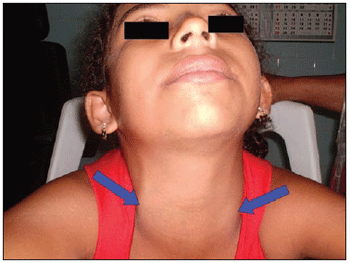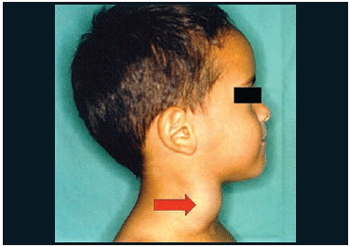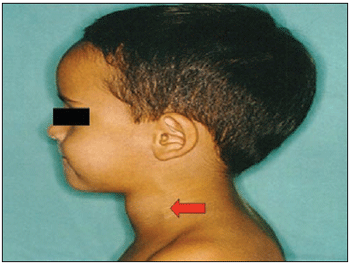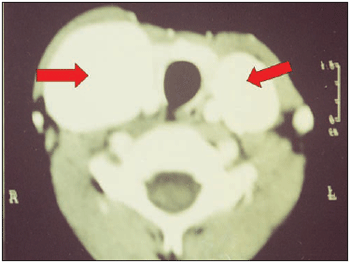 |
429 |
|
| Year: 2007 Vol. 11 Num. 2 - Abr/Jun - (21º)
|
|
 |
|
|
| Bilateral Internal Jugular Phlebectasia |
|
| Author(s): |
| Lidiane Maria de Brito Macedo Ferreira1, Érik Frota Haguette2
|
|
|
| Key words: |
| Jugular veins. Ectasia. Child. |
|
|
 |
| Abstract: |
Introduction: Internal jugular phlebectasia is a fusiform dilatation of the internal jugular vein. The clinical findings are enlargement of the neck during straining and Valsalva manoever. The main differential diagnosis is laryngocele. Aim: The authors present two cases of fusiform ectasias of both internal jugular veins in children a review of the literature. Case Report: MHN, female, 5 years old and HOT, male, 4 years old,both with enlargement of the neck. The diagnosis were Internal jugular phlebectasia. No treatment was indicated. Conclusion: The case are rare, and the differential diagnosis and treatment are vital.
|
|
 |
INTRODUCTION
The venous ectasia, or phebectasia as it is also called, is a rare entity that consists of the fusiform dilatation of the veins. Once they present thin walls, the veins are the vascular structures which are frequently , propitiating its dilatation. In the neck, this occurs during the Valvalsa Manouver, revealing aspect of cervical enlargement. Phlebectasias are described mainly in internal jugular vein, but they can also affect the external jugular vein, anterior jugular vein and superficial cervical communicating veins.
The jugular ectasia is a congenital alteration, and therefore it is more generally diagnosed in children. The relation man: woman is 2:1(1) or 3:2(2) (there are controversies), and the predominance is in the right side (5,8:1)(2), and the bilateral cases are rare. It is not known, however, the cause of this predominance. The diagnosis must be precocious to differentiate from other pathologies, as well as to guide adequate treatment when it is necessary.
OBJECTIVE
We report two cases in children, one male and one female, both with bilateral dilatation of the internal jugular veins, which become interesting cases for their rarity. The diagnosis in these cases presents importance for the congenital differentiation between laryngoceles or other malformations, which require treatment or present risk to the infant patient.
CASE REPORTS
The first case is of MHN, female, 5 years old (Figure 1), who went to otorhinolaryngology service once her mother complained that "the child's neck would always swell" when she cried out or made great efforts, since her birth. She denied dysphonia, dysphagia, odynofagya, dyspnoea, fever. She did not have antecedents of traumas, cervical surgeries or pathologies.
 Figures 1. MHN, female, 5 years old - Exam revealing right cervical enlargement at Valvalsa Manouver.
At the physical examination, we observe good general condition, health, stable vital signs which were within normality standards. Oroscopy, rhinoscopy and otoscopy had no alterations. Palpation of neck at rest had no alterations either. However, when requesting the child to make effort, simulating a Valsalva maneuver, we observe enlargement of the cervical regions bilaterally anterior - lateral, approximately in levels II, III and IV, symmetrical, and which returned to the original position after the effort was ceased. The enlargement had soft and immovable consistency, however without characteristics of fixed nodulations.
A nasofibrolaryngoscopy was carried through, which had no alterations.
It was then requested cervical echography with doopler, which revealed bilaterally increase of the size and the flow of the internal jugular veins at the Valsalva maneuver. A CT scan was also requested, however it was not possible carry it out with the Valsalva maneuver and the ectasia could not be registered.
The child remains then in clinical assistance until nowadays, without other complaints.
The second case refers to HOT, male, 4 years (Figures 2 and 3), with similar history. The mother went to the otorhinolaryngology clinic once she realized enlargement in the anterior cervical region of her son when he cried or made efforts. She did not relate pain, breathlessness or another pharyngeal symptom.
 Figure 2. HOT, male, 4 years old - Exam revealing right cervical enlargement at Valvalsa Manouver.  Figure 3. HOT, male, 4 years old - Exam revealing right cervical enlargement at Valvalsa Manouver.
At the examination, we ectoscopically observe absence of alterations, with the exception of the visible enlargement when the child made some type of effort. The enlargement was bilateral, bigger to the left, with cystic consistency and without adherence at deep planes. Above the sternocleidomastoid muscle. Without cervical adenomegalies.
Nasofibrolaryngoscopy revealed absence of alterations.
CT scan with contrast (Figures 4 and 5), carried out with prolonged Valsalva maneuver confirmed the diagnosis of ectasia of bilateral internal jugular vein, with fulfilling of contrast in the turgid veins.
 Figure 4. Cervical CT Scan during the Valsalva Manouver- Exam revealing internal jugular vein diameter enlargement bilaterally.  Figure 5. Cervical CT Scan with contrast during the Valsalva Manouver- Exam revealing internal jugular vein diameter enlargement bilaterally.
DISCUSSION
It is estimated that less than 50 cases of jugular(3) ectasia have been described in medical literature, although there is a general agreement that these numbers must be bigger for being unnoticed in the daily clinics. The first described case was in 1928 for Harris(3), who described it as venous anomaly that involved the right jugular, innominate and thyroidal inferior veins.
The possible causes for the internal jugular vein dilatation are: anomalous reduplication (described in the Zukschwerdt case in 1929), pressure of the scalene muscle (described by Rowe in 1946), and compression of the innominate vein (suggested by LaMonte in 1976). In most of the cases, however, they remain as idiopathic(4). What is observed in most of the cases is a reduction in the elastic fibers that compose the layers of the venous wall.
When it is unilaterally presented, the evident symptoms are few, except for the visualization of the increase of cervical volume at efforts. It is revealed as a non-pulsatile mass, of cystic aspect, round or fusiforme, located at suprasternal or supraclavicular levels, or in the previous border of the sternocleidomastoid muscle, and painless at palpation. When it is proceeded to the Valsalva maneuver, compression of the inferior extremity of the ectasia occurs, and its consequent enlargement.
The diagnosis is basically clinical, being confirmed based with ecography with doopler, which reveals a fusiforme aneurismatic formation in the internal jugular vein during the Valsalva maneuver. Currently, the CT scan can also be used for diagnostic confirmation, revealing the venous dilatation at the moment of the Valsalva maneuver. However, the ecography still is the election method for being non-invasive and less expensive. It is important to point out that in both methods the contribution of the patient in terms of performance of effort at the moment of the examination is needed, so that the increase of the intra-thoracic pressure can reveal the venous dilatation. Without the Valsalva maneuver, the examination does not confirm the suspicion.
The distinguishing disgnostic consist basically of the cervical masses that increase its volume with effort, as it is the case of external laryngocele (main cause of cervical enlargement at the Valsalva maneuver) and of the branchial or mediastinum cysts. Other causes of cervical enlargements that do not have variation of size at effort are ignored right at physical examination.
The treatment basically depends on the presence or not of complications. If there is compression of vascular structures, infections, thromboses or rupture of dilatation, the surgical treatment is necessary. It consists of the resection of the dilated segment or covering with muscular segment (generally of the omohyoid muscle) which works compressing and giving tonus to the flat regions(5). However, in the bilateral cases, the resection of the two ectasias is contraindicated by the possibility to cause cerebral edema(6). In most of the cases, however, for being asymptomatic and causing only aesthetic alterations, the attending(1,7) conducts has predominance.
CONCLUSION
The jugular vein ectasia is an uncommon finding, but frequently diagnosed in children for the clinical signs it presents. In the two diagnosed cases in our clinic, the conduct was attending once the clinical pictures are asymptomatic.
BIBLIOGRAPHY
1. Pul N, Pul M. External jugular phlebectasia in children. Eur J Pediatr 1995; 154:275-6.
2. Walsh RM, Lanningan JÁ, Bowdler DA. Jugular bulb phlebectasia. Int J Pediatr Otorhinolaryngol 1993; 25:249-54.
3. Ocampos JR, Granato L, Padula F. Flebectasia da jugular interna em criança. Relato de caso e revisão da literatura. Rev Bras Otorrinolaringol 1999; 65:181-4.
4. Leung A, Hampson SJ, Chir B, Singh MP, Carr D. Ultrasonic diagnosis of bilateral congenital internal jugular venous aneurysms. Br J Radiol 1983; 56:588-91.
5. Uche MG, Vargas HT, Zabalza MEE, Sola JJM. Flebectasia yugular. A propósito de dos casos. Na otorrinolaringol Ibero Am 1996; 23:235-41.
6. Walsh RM, Murty GE, Bradley PJ. Bilateral internal jugular phlebectasia. J Laryngol Otol 1992; 106:753-4.
7. Al-Dousary S. Internal jugular phlebectasia. Int J Pediatr Otorhinolaryngol 1997; 38:273-80.
1. Doctor (otorhinolaryngologist resident at Hospital Geral de Fortaleza/CE)
2. Otorhinolaryngologist doctor (otorhinolaryngologist resident chief at Hospital Geral de Fortaleza/CE)
Hospital Geral de Fortaleza - CE
Lidiane Ferreira
Asdress: 5353, Washington Soares Ave - bl 4 ap 202 - Zipcode: 60830030 - Fortaleza/CE - E-mail: lidianembm@yahoo.com.br - Fax: (85)34866400
This article was submitted to SGP (Sistema de Gestão de Publicações) of R@IO on August 6, 2006 and approved on November 14, 2006 at 03:26:36.
|
|
 |
|
|
